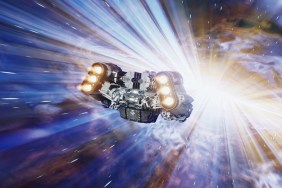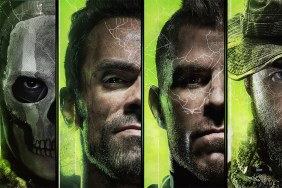Don’t mess with Texas. Really.
It may take all kinds to make the world go ’round, but the number of “all kinds” increases radically once you start factoring split personalities into the equation. What – besides such mental pathology, I mean – could possibly account for a normally flag-waving, Red, White and Blue, Yankee-Doodle-Dingus like me taking so much guilty pleasure in the (fictional) downfall of the United States?
One’s limited entertainment options here run from relatively high art (some of the better ‘alternate history’ sci-fi) to the unapologetically campy (the Red Alert computer game series) to the truly crappy (Red Dawn, starring Patrick Swayze, not to be confused with the even crappier Steel Dawn, starring Patrick Swayze). Shattered Union resides in the more respectable end of this “Red, White and Doom” spectrum, even with its reign-bow of error, its axis of evil flaws.
[image1]America, 2013: An increasingly unpopular prez is voted back into office, domestic unrest is on the rise, and the geopolitical levee breaks when Washington, D.C. is laid to waste by a low yield nuke, effectively decapitating the incumbent administration. An extremely unlikely fractioning of the Union into independent military/industrial regions rapidly follows, and players are charged with cobbling Uncle Humpty Sam back together again the old-fashioned way: by force.
On the tactical level, it wouldn’t be too far off the mark to think of Shattered Union as a better-looking, hex-based homage to Advance Wars. In turn-based combat, players control a wide variety of armored, artillery, air, anti-air, infantry and other special units on a 3D map than can be zoomed and rotated at will. Good thing too, because the game’s default camera seems to take particular pleasure in routinely re-orienting your point of view, making it tougher to keep the tactical situation clear.
A Risk-style strategic map shows the initial fragmentation of the country, with such new territories as the Pacific Northwest’s Arcadia, the Heartland Coalition, the “New England Alliance,” God-help-us-all Dixieland, and even (cue the irony) expeditionary “peacekeeping” forces sent from Europe to stabilize the Stateside situation! The actual work of battling to reunify the nation takes place on a closer scale, with maps showcasing each region’s major cities and general geographical layout.
This includes landmarks like the St. Louis Arch, Seattle’s Space Needle, and San Francisco’s Golden Gate Bridge – all of which are subject to destruction – with obvious political consequences for the faction responsible for their elimination. Blow out a treasured icon in the course of a battle, and the political fallout might just lose you the greater war in the long run (add to that the fact that in some maps, such as Northern California/San Francisco, bridges can be crucial logistical targets in purely military terms).
[image2]The political reputation scheme is directly tied to how much collateral damage you inflict on the national corpus. Players who keep the splash damage on our national heritage to a minimum will receive special ability options different from those who gleefully send the Golden Gate crashing into the bay just to thwart the advance of a few enemy units.
As the player’s political rep slides into the nominally ‘positive’ or ‘negative,’ new unique battlefield abilities reflect his policy. For example, relative do-gooders may get precision-guided munitions or the comparatively ‘green’ unit-disabling Electromagnetic Pulse attack, while nastier gamers acquire indiscriminate carpet-bombing runs or even a devastating tactical nuke, roiling mushroom cloud and all (which, for some reason, always seems to end up being used on Los Angeles. Or maybe it’s just us.) Each approach has its cold, logical advantages and disadvantages, although after the relatively limp-wristed missile silos of Advance Wars, seeing a whole cluster of map-hexes spectacularly reduced to radioactive grit by a Shattered Union nuke definitely reaffirmed our faith in and appreciation of turn-based strategic weapons.
One other welcomed feature, one missing from some recent turn-based strategy games, is the ability to lay mines on certain hexes of the battlefield. Of course, suspicious enemies can sweep suspect zones clear of mines at the cost of leading their attack force with expensive, relatively fragile engineering units. Each faction also has at least one specialized unit, such as the Euro Union armor that can move and lay minefields simultaneously. In this way, Shattered Union lends some individuality to the various factions, beyond the expected, commonplace stat-tweaking of generic, analogous armor, infantry and air units.
There isn’t one core problem with Shattered Union, but the tiny bits of shrapnel from scattered, unrelated problems make the battlefield dicey. The game’s sad excuse for a “tutorial” is just horrible, a read-only primer that’s essentially a slideshow, with no interactivity whatsoever. Aren’t we beyond this? MUST we, in fact, actually read the whole damn manual?
[image3]Other issues arise in-game. Any forces earmarked for a given battle in the strategic map are effectively taken out of play for any given enemy’s counterattack, and the A.I. seems to have an unhealthy, evil eye for always striking back at you where and when you’ve left yourself no reinforcements. Once in a while, this makes for a challenging game; all the time, when the enemy doesn’t seem to have the same info blackout you do, and it smacks of cheating. It also turns the game into an overdrawn, back-and-forth, frustrating game of getting ganged-up on by all the other sides.
The overall story, which starts off with those promising, pessimistic CNN-style newsflashes, is quickly left by the wayside with little in terms of dramatic presentation. It just feels like the designers could have tried harder here. The game isn’t a graphical disaster by any means, but They also could have tried to remedy that problematic camera, which suffers from the aforementioned habit of needlessly re-orienting between turns, making an already complex battlefield needlessly chaotic.
But once you conquer the somewhat opaque learning curve, Shattered Union offers that nice, niggly, military need for attention to detail. The decidedly fragile environments and variety of units give players a sense of having something to fight for in both campaign and multiplayer beyond the unchanging battlefields of the typical turn-based strategy game. More depth and better delivery would have made this war far more civil.
-
Solid beer & pretzels strategy
-
'Reputation' scheme
-
Cool premise
-
Which is promptly neglected
-
Lazy, non-interactive tutorials
-
Wonky camera
-
Anemic overworld strategizing











